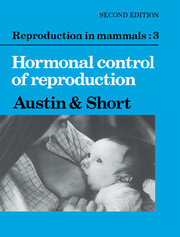Book contents
- Frontmatter
- Contents
- Contributors to Book 3
- Preface to the Second Edition
- Books in the First Edition
- Books in the Second Edition
- 1 The hypothalamus and anterior pituitary gland
- 2 The posterior pituitary
- 3 The pineal gland
- 4 The testis
- 5 The ovary
- 6 Oestrous and menstrual cycles
- 7 Pregnancy
- 8 Lactation
- Index
7 - Pregnancy
Published online by Cambridge University Press: 05 June 2012
- Frontmatter
- Contents
- Contributors to Book 3
- Preface to the Second Edition
- Books in the First Edition
- Books in the Second Edition
- 1 The hypothalamus and anterior pituitary gland
- 2 The posterior pituitary
- 3 The pineal gland
- 4 The testis
- 5 The ovary
- 6 Oestrous and menstrual cycles
- 7 Pregnancy
- 8 Lactation
- Index
Summary
Hormones have important regulatory roles in pregnancy from the moment of ovulation and fertilization to the delivery of young; in this chapter we shall be concerned with how hormones regulate the maternal adjustments to pregnancy, and how their secretion is controlled to meet the needs of uterine gestation. When viviparity emerged as the preferred mode of reproduction in eutherian and marsupial mammals, hormones were exploited to control the physiological adjustments of the mother. The success of viviparity in eutherians and marsupials was due to several important features: reduction in the yolk content of the eggs, development of the placenta, retention of the young within the female genital tract, and parental care of the offspring, especially including their nutrition. Such functions presented problems for maternal homeostasis, and one of the ways by which these were solved involved the exploitation of pre-existing molecules (steroids and polypeptides) as regulators of organ function. The sex hormones and gonadotrophins of mammals are widely distributed in Nature and are also involved in reproduction in many non-mammalian species. A study of the role of hormones in pregnancy therefore provides an exciting opportunity to see the uses to which these conserved molecules have been put in the evolution of viviparity.
Endocrine regulation of pregnancy primarily involves hormones of the pituitary, the ovary, and the placenta, and a distinction can be drawn between these organs and those, such as thyroid, adrenal and parathyroid, whose role is more of a supportive or permissive one.
- Type
- Chapter
- Information
- Reproduction in Mammals , pp. 153 - 194Publisher: Cambridge University PressPrint publication year: 1984
- 10
- Cited by

